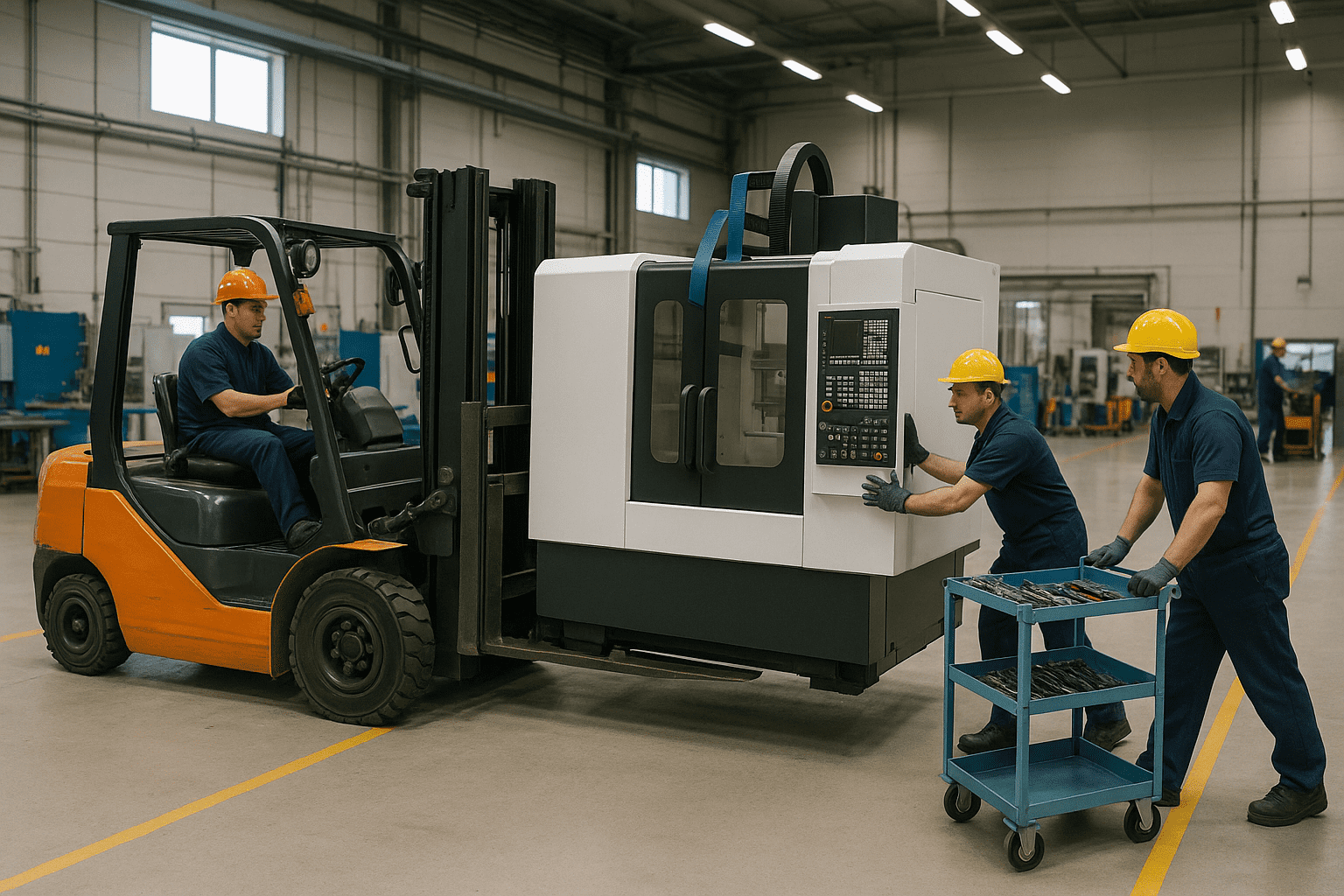Equipment Redeployment: What It Is & How to Do It Right

Introduction
Idle equipment and underutilized tools often sit in storage, adding unnecessary costs to your business without contributing to production. These assets, when not properly redeployed, can become a significant drain on operational budgets, as they tie up capital, incur maintenance costs, and occupy valuable space.
Equipment redeployment is a strategic practice that manufacturers, industrial plants, and large-scale operations must embrace to maximize asset efficiency and optimize performance. By strategically moving underused assets to areas where they are most needed, companies can reduce downtime, improve operational efficiency, and unlock hidden value in their existing resources.
In this blog, we’ll explore the importance of equipment redeployment and provide actionable insights on how to effectively implement it in your organization for improved asset utilization and cost savings.
What Is Equipment Redeployment?

Equipment redeployment refers to the process of relocating or repurposing equipment, tools, and machinery from one area of operation to another to optimize their use and extend their lifespan. Instead of purchasing new assets or letting existing ones sit idle, redeployment ensures that equipment is put to work where it is most needed, thereby maximizing value and reducing waste.
Unlike equipment replacement or procurement, which typically involve acquiring new or upgraded equipment, equipment redeployment is a cost-effective alternative for a business that leverages existing resources. It avoids the significant capital expenditures and lead times associated with buying new assets, while also minimizing the environmental impact by reducing unnecessary production and disposal of equipment.
Why It's Essential?
- Manage Asset Utilization
Equipment redeployment allows businesses to maximize the use of existing assets, ensuring that idle equipment is reassigned to areas where it can provide value. This practice optimizes resource allocation, improving operational productivity without the need for additional investments in new equipment.
- Extend Equipment Lifecycle:
By redeploying equipment, businesses can extend the life of their machinery and tools, reducing the need for early replacements. Regularly relocating equipment to new roles or environments ensures that they remain productive and continue to meet operational needs, thereby maximizing the return on investment.
- Reduce Costs:
Redeployment directly reduces costs related to purchasing new equipment. Instead of buying new machinery or tools for each new project or need, businesses can make full use of their existing assets, saving capital expenditure. Additionally, redeploying assets reduces storage costs as unused equipment isn’t occupying valuable space.
- Landfill Diversion:
Redeployment helps divert equipment from landfills, supporting sustainability initiatives. By reusing and repurposing equipment, companies contribute to a circular economy, keeping materials and resources in circulation instead of letting them go to waste. This not only aligns with environmental goals but also boosts a company’s sustainability profile, which can be critical for brand reputation and compliance.
How to Do Equipment Redeployment Right

1. Assessing Equipment Availability Across Different Facilities
The first step in successful equipment redeployment is understanding what you have and where it’s located in your organization. Often, equipment that is surplus in one internal facility could be in high demand in another. However, facilities typically manage their own inventory, which means they aren’t always aware of what’s available in other locations. This can create inefficiencies, as needed parts or machinery might go unused, while other sites face shortages.
To ensure effective redeployment, start by creating an accurate inventory of all available equipment across your organization. Categorize equipment based on condition, functionality, and suitability for redeployment to identify which assets can be reassigned to other locations or projects. This assessment allows you to better manage surplus assets and avoid unnecessary purchases.
Amplio can help with internal equipment redeployment by offering an intelligent AI-powered inventory analysis tool, which matches exact and similar parts across facilities, enabling easy internal transfers and improving asset management efficiency.
2. Condition Evaluation
Before redeploying equipment, it’s essential to assess its condition to ensure it is suitable for its new role. This evaluation process involves reviewing detailed condition reports, maintenance history, and performance data to determine whether the equipment meets the required standards for redeployment.
- Condition Reports: Check for any wear and tear, recent repairs, or operational issues that may affect its performance in a new setting.
- Maintenance History: Review past maintenance logs to identify recurring issues, parts that have been replaced frequently, or any equipment that might soon require major repairs.
- Performance Data: Evaluate performance metrics such as uptime, operational efficiency, and output capacity to ensure the equipment is still capable of meeting production demands.
3. Matching Equipment to New Roles or Locations
Once you’ve evaluated the condition and operational readiness of surplus equipment, the next step is to assess the business needs across different departments, projects, or locations.
Identify areas where specific equipment is required and match these needs with underutilized assets. By strategically targeting the areas that will benefit most from redeployment, you ensure that equipment is used where it can provide the highest value, ultimately enhancing productivity and efficiency across the organization.
Also, evaluate whether the equipment should be redeployed within the same facility or moved to a different location. Consider factors like transportation, setup costs, and any required modifications for the new environment. While redeploying equipment within the same facility can reduce logistical challenges, relocating equipment to another site may offer better long-term value.
4. Ship Equipment and Parts to Destination
Shipping equipment and parts to their new destination can be one of the most challenging aspects of the redeployment process. Even when businesses have successfully identified parts for transfer between facilities, the personnel at the receiving location often lack familiarity with the logistics and procedures involved in proper shipping and handling. This can lead to delays, mishandling, or equipment being out of service longer than necessary.
To minimize disruption, it’s crucial to plan the logistics process carefully. Establish clear guidelines and protocols for packaging, labeling, and handling to ensure that equipment arrives safely and in good condition.
Coordinating with logistics teams and even third-party shipping experts ensures a smooth transition and reduces the burden on facility staff. By streamlining the shipping process, you can maintain minimal downtime and ensure the timely redeployment of critical assets.
5 Performance Monitoring:
Once equipment has been redeployed, ongoing performance monitoring is necessary to ensure it meets operational expectations in its new role.
By regularly assessing its efficiency, productivity, and maintenance needs, you can address any issues promptly, ensuring that redeployed assets continue to deliver value without causing disruptions. Performance data should be reviewed periodically to determine if further redeployment or adjustment is required.
Utilizing Bill of Materials (BOM) tools or asset tracking software is critical for efficiently managing the lifecycle of redeployed equipment. These tools allow you to track the movement, condition, and performance of assets across multiple projects or locations, ensuring transparency and accurate asset tracking. BOM tools help maintain visibility, allowing you to identify and address potential issues with redeployed assets early.
How Amplio Supports Equipment Redeployment
- AI-Driven Asset Matching:
Amplio’s intelligent AI tools analyze your organization’s equipment inventory, identifying surplus assets and matching them with areas of need. This automated process ensures that assets are redeployed quickly and efficiently, reducing downtime and increasing equipment utilization.
- Global Network for Surplus:
Gain access to Amplio’s trusted network of vetted industrial buyers and sellers. This extensive network makes it easier to facilitate redeployment or resale of excess equipment, ensuring that surplus parts or machinery find new value in other industries or locations.
- Real-Time Tracking & Reporting:
Amplio’s user-friendly dashboards provide real-time visibility into your equipment’s status, availability, and usage across the supply chain. This data-driven approach allows you to monitor asset performance, streamline redeployment processes, and ensure continuous operational efficiency.
Contact us for expert guidance on optimizing your equipment redeployment strategy. Enhance asset utilization, reduce costs, and boost operational efficiency with our innovative solutions.